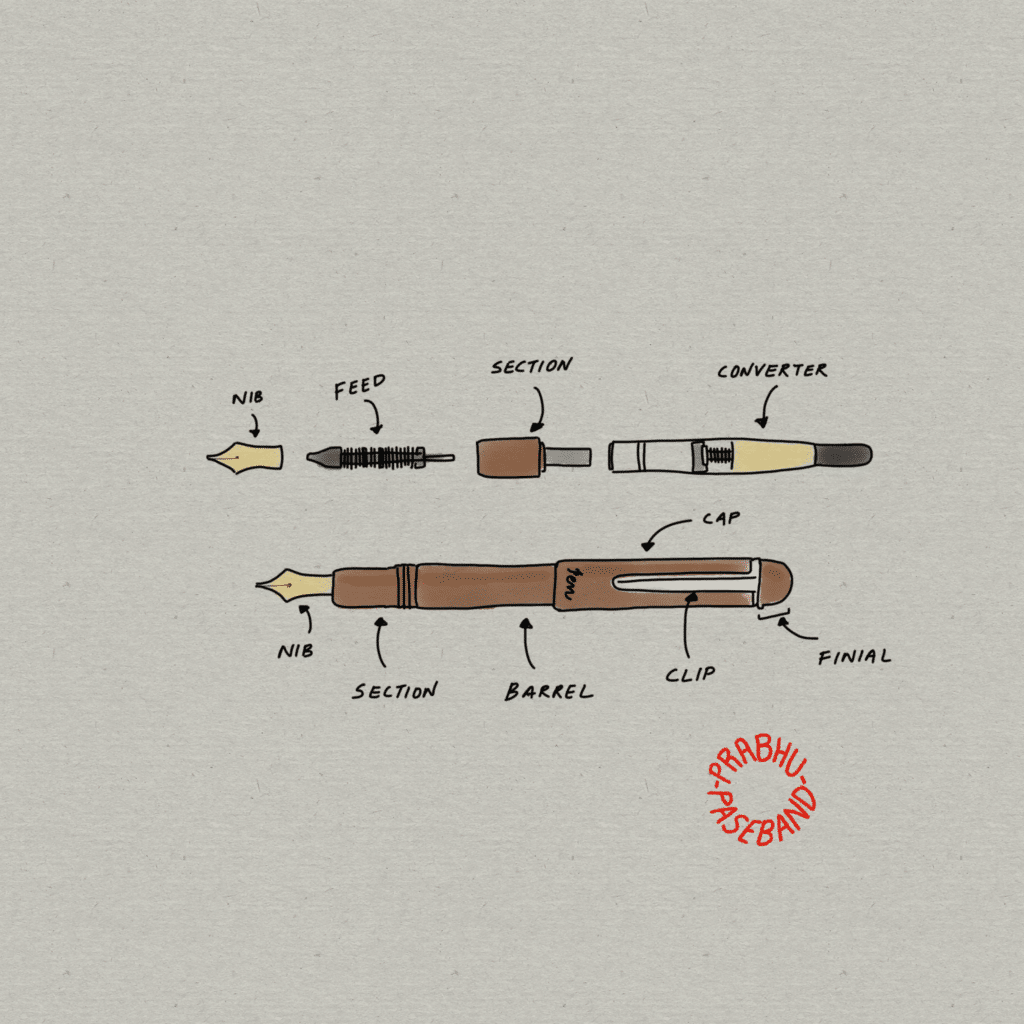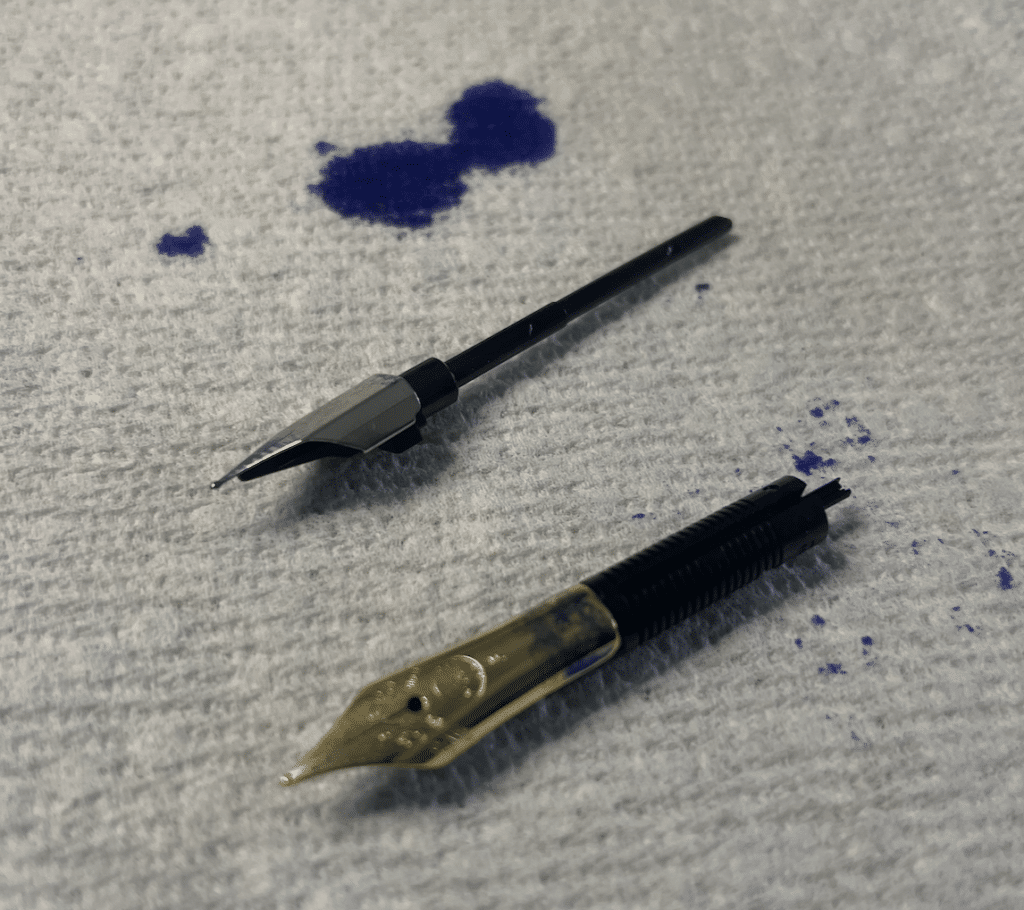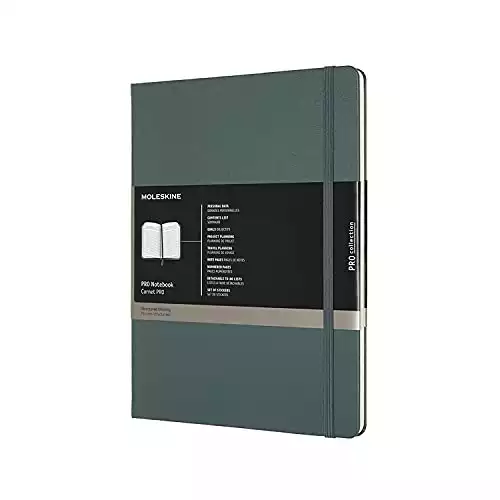Fountain pens, the stylish and classy writing tool, need some love and care to keep them in top shape. Just like your pet puppy, they might act up sometimes, but don’t worry! There are plenty of tricks you can use to get them back in line. This guide will help you get to know your fountain pen better and learn how to fix some common troubles you might run into.
Getting to Know Your Fountain Pen
Before you start fixing things, let’s understand the parts of a fountain pen: the nib, feed, grip, and ink reservoir. Think of the nib as the paws of your pen, touching the paper and leaving its ink pawprints. The feed, which sits under the nib, is like the heart, controlling the flow of ink. The grip is where you hold your pen, and the ink reservoir is where the pen’s “food” – the ink – is stored.

Fountain pens come in all shapes and sizes. And as you pick your first fountain pen, you’ll want to explore the different options.
Fountain pen nibs also come in a variety of sizes and materials, with gold and steel being the most common. Gold nibs are flexible and give a smooth writing experience. Steel nibs are tough and more affordable. The size of the nib will affect how thick the lines you write are — fine nibs make thin lines and broad nibs make thicker lines.
The ink you use in your fountain pen can vary depending on colors, shimmers, and solubility. Lots of different brands and colors are available. Always remember to use high-quality ink to avoid any nasty clogs in your pen’s feed.
To keep your fountain pen happy and healthy, clean it regularly to prevent ink buildup. Wipe it down with a soft cloth, and clean out the ink reservoir with a bulb syringe or pen flush. Store your fountain pen properly to keep it safe from harm.
Knowing your fountain pen and taking good care of it means you can enjoy the elegant writing it offers. So whether you’re a fountain pen expert or just a newbie, good pen care will make your pen last for many years to come.
Problem 1: Ink Not Flowing Smoothly
The number one troublemaker is ink not flowing correctly. This can make your pen skip or drag or write dry lines. If your pen’s acting this way, here are some tips:
Give the nib and feed a good wash and let them have an overnight soak in a mix of water and ammonia.
Try a different ink color or brand – some inks are thick and need broad nib pens to flow properly.
Check if the feed is lined up right with the nib. If they’re not in line, this can mess up the ink flow.
Remember that how you write can also affect the ink flow. If you press too hard on the nib or hold your pen at a weird angle, the ink may not flow right. Try changing your grip or writing style to see if it helps.
The type of paper you use can also mess with the ink flow. If your paper is too absorbent or too glossy, it can cause the ink to spread or not flow properly. Try out different kinds of fountain pen-friendly notebooks to find the best match for your pen and ink.
If you love a Moleskin but want to use your pens, look for the PRO edition, which has a thicker paper weight. So it's more fountain-pen friendly.
If you’re still having trouble, check your pen for any physical damage. A bent nib or a damaged feed can disrupt ink flow. If you spot any damage, take your pen to a pro for repairs.
Download this cheatsheet and get expert solutions for the 13 most common pen problems.
Get The FREE CheatsheetProblem 2: Leaky Pen
A leaking pen can cause a mess and ruin your work. Here’s why it happens and how to fix it:
Sometimes, a nib and feed that don’t fit right with the pen barrel can cause leaks. If this is the problem, gently push the nib and feed into the barrel to make sure it’s snug.
A cracked or damaged ink reservoir can leak ink. Over time, the plastic or glass reservoir can get brittle and crack. If you think this is the problem, you might need to replace the reservoir. You can buy a new one from the pen maker or from a different supplier.
How you use and store your pen also matters. If you travel a lot with your pen, it might leak because it’s being stored sideways. Try to keep your pen upright. You might also want to get a pen case or sleeve to keep your pen safe and prevent it from rolling around.
Problem 3: Scratchy Nib
A scratchy nib can be annoying and make writing smoothly tough. But there are steps you can take to fix it.
First, check the nib’s alignment with the feed. A misaligned nib can scrape the paper and feel scratchy. You can use a loupe or magnifying glass to check if the nib’s tines are aligned. If they’re misaligned, gently adjust them with your fingers or a nib tuning tool.
Next, you might need to polish the nib. This can be done with a very fine abrasive material like micro-mesh. This step should be done carefully and as a last resort since you don’t want to remove too much material from the nib.

Another thing that can make a nib scratchy is if it’s dirty. Ink and paper fibers can build up over time and make the nib feel scratchy. Cleaning your nib regularly can help prevent this. Just remember to rinse the nib thoroughly after using pen cleaning solutions.
Lastly, the paper you’re using can affect how smooth your pen feels. Rough paper can make even the smoothest nib feel scratchy. Try using a smoother paper to see if this fixes the problem.
Problem 4: The Nib is Damaged
If the nib of your pen is damaged or bent, it may affect the ink flow and the smoothness of your writing. Here’s how to handle a damaged nib.
If the nib is only slightly bent or misaligned, you might be able to fix it yourself. You can use a loupe to inspect the nib closely, and with gentle pressure, realign the tines. Be careful, though, as too much pressure could cause further damage.
If the nib is seriously bent or broken, you will likely need a replacement. Some pen manufacturers offer replacement nibs, or you can take it to a professional nibmeister for repair or replacement. This may be expensive, but it’s usually cheaper than buying a new pen.
Remember that prevention is better than cure! To avoid damaging the nib, avoid dropping your pen, especially nib-down. Don’t apply too much pressure when writing – let the ink flow naturally with the weight of the pen. Store your pen properly when not in use to protect the nib.
These are the most common problems you may encounter with your fountain pen and the best ways to solve them. Remember, a well-maintained fountain pen can last a lifetime, providing a unique and pleasurable writing experience. It’s worth the time and effort to care for your fountain pen properly.
Problem 5: Inconsistent Ink Flow
If your pen is creating uneven lines or skipping while writing, this could mean there’s a problem with the ink flow. Try these solutions:
One common cause is a blocked feed system. This can happen if the ink dries up in the feed or debris is trapped in it. To fix this, rinse the nib and feed thoroughly with water. If that doesn’t work, you might need to soak the nib and feed in a solution of water and gentle dish soap.
Sometimes, the type of ink you’re using could cause this problem. Some inks are thicker or drier than others. If you notice inconsistent ink flow, you could try switching to a different brand or type of ink.
Another possible reason is an issue with the nib and feed alignment. The feed provides a continuous supply of ink to the nib. If they aren’t aligned properly, this can disrupt the flow. You can use a loupe to check if they are aligned and adjust them gently with your fingers.
Keeping Your Pen in Great Shape: Cleaning and Maintenance
After you’ve solved your pen problem, it’s important to keep it in great shape to avoid future issues. Regular cleaning and proper maintenance are key:
Regular Cleaning: About once a month, or every time you change ink colors, properly clean the pen by rising it with water. This helps prevent ink from drying and clogging the feed. If your pen is particularly dirty, you might need to soak the nib and feed in a soapy solution.
Proper Storage: When not in use, store your pen upright with the cap on. This helps prevent ink from drying up in the feed and nib. It also protects the nib from damage.
Handling and Usage: When writing, don’t press too hard on the page. Fountain pens require a light touch. Also, remember not to lend your pen to others who might not know how to handle it correctly. And you may need special nibs if you’re a lefty.
Remember, a well-looked-after fountain pen can serve you for a lifetime. You’ll be able to enjoy the beauty and sophistication of using a fountain pen if you take these steps to care for it.
Filling Your Pen Properly: Some Quick Tips
Knowing how to fill your fountain pen correctly is essential for preventing fountain pen problems like ink flow issues. Here’s a quick guide:
Twist or slide open the pen’s barrel to expose the ink reservoir. You should be able to see the filling mechanism. Follow these tips if your pen uses a cartridge or a converter.
If your pen uses a piston filling system, dip the nib into your ink bottle and twist the end of the pen to draw ink up into the reservoir. If you’re using a cartridge or converter, simply insert the cartridge or fill the converter using a pipette or the provided filler.
Make sure not to overfill the reservoir. This could cause the ink to leak or flow inconsistently.
Once filled, let your pen sit for a couple of minutes before you start writing. This allows the ink to flow down to the nib and feed.
Take Care of Your Pen for a Better Writing Experience
Care for your pen, keep it clean, use the right inks and notebooks, and you should have a great experience.
Remember, learning to care for and troubleshoot your fountain pen is part of the journey of owning one. With these tips, you can keep your pen in top shape and continue to enjoy the elegant and satisfying experience of writing with a fountain pen.
Liz
Hey, I'm Liz. I'm the founder of this thing. Pen-obsessed and a notebook nut, I love writing by hand. So I'm gonna talk about it on a computer.Download this cheatsheet and get expert solutions for the 13 most common pen problems.
Get The FREE Cheatsheet
